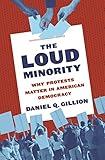The Loud Minority : Why Protests Matter in American Democracy / Daniel Q. Gillion.
Material type: TextSeries: Princeton Studies in Political Behavior ; 9Publisher: Princeton, NJ : Princeton University Press, [2020]Copyright date: ©2020Description: 1 online resource (224 p.) : 17 b/w illus. 7 tablesContent type:
TextSeries: Princeton Studies in Political Behavior ; 9Publisher: Princeton, NJ : Princeton University Press, [2020]Copyright date: ©2020Description: 1 online resource (224 p.) : 17 b/w illus. 7 tablesContent type: - 9780691181776
- 9780691201726
- Democracy -- United States
- Protest movements -- United States
- POLITICAL SCIENCE / American Government / General
- 2020 elections
- American National Election Study
- American politics
- Angela Davis
- Black Lives Matter
- Civil Rights Act
- Discrimination, Jobs, Politics
- Faithful and Fearless
- Federal Election Committee
- Freedom is a Constant Struggle
- From #BlackLivesMatter to Black Liberation
- Keeanga Yamahtta Taylor
- Kenneth Andrews
- LGBT community
- Martin Luther King
- Mary Fainsod Katzenstein
- Mobilizing Public Opinion
- Paul Burstein
- Political Process and the Development of the Black Insurgency
- Taeku Lee
- Tea Party activists
- U.S. elections
- Vietnam War
- Voting Rights Act
- a change is gonna come
- campaign contributions
- civil rights movement
- congressional elections
- countermobilization
- democratic national convention
- electoral opportunity
- electorate influence
- free-riding
- ideological protest
- liberal and conservative protests
- partisanship
- polarization
- political backlash
- political behavior
- political campaigns
- political communication
- political primaries
- protest narrative
- race and ethnic politics
- republican national convention
- sit-ins
- social movements
- women's rights
- 303.484 23
- HM883 .G555 2020
- online - DeGruyter
- Issued also in print.
| Item type | Current library | Call number | URL | Status | Notes | Barcode | |
|---|---|---|---|---|---|---|---|
 eBook
eBook
|
Biblioteca "Angelicum" Pont. Univ. S.Tommaso d'Aquino Nuvola online | online - DeGruyter (Browse shelf(Opens below)) | Online access | Not for loan (Accesso limitato) | Accesso per gli utenti autorizzati / Access for authorized users | (dgr)9780691201726 |
Frontmatter -- CONTENTS -- Acknowledgments -- Introduction -- 1. Ideological Protests: The Protest Ties That Bind Us Together -- 2. The Making of Ideological Protests -- 3. Political Primaries: Protest's Ideological Connection at the Republican and Democratic National Conventions -- 4. Campaign Contributions: Following the Money to Find the Financial Benefits of Protest -- 5. Voter Turnout: Does Protest Lead to Voter Support or Public Backlash? The Case of Black Lives Matter -- 6. Election Results: A Protest Political Climate That Shapes Electoral Opportunities and Candidates' Fortunes -- Conclusion: A Change Is Gonna Come . . . a Protest Change Is Always Gonna Come -- References -- Index
restricted access online access with authorization star
http://purl.org/coar/access_right/c_16ec
How political protests and activism have a direct influence on voter and candidate behavior The "silent majority"-a phrase coined by Richard Nixon in 1969 in response to Vietnam War protests and later used by Donald Trump as a campaign slogan-refers to the supposed wedge that exists between protestors in the street and the voters at home. The Loud Minority upends this view by demonstrating that voters are in fact directly informed and influenced by protest activism. Consequently, as protests grow in America, every facet of the electoral process is touched by this loud minority, benefitting the political party perceived to be the most supportive of the protestors' messaging.Relying on historical evidence, statistical data, and detailed interviews that consider protest activity since the 1960s, Daniel Gillion shows that electoral districts with protest activity are more likely to see increased voter turnout at the polls. Surprisingly, protest activities are also moneymaking endeavors for electoral politics, as voters donate more to political candidates who share the ideological leanings of activists. Finally, protests are a signal of political problems, encouraging experienced political challengers to run for office and hurting incumbents' chances of winning reelection. The silent majority may not speak with protest actions themselves, but clearly gesture for social change with their vote.An exploration of how protests affect voter behavior and warn of future electoral changes, The Loud Minority looks at the many ways that activism can shape democracy.
Issued also in print.
Mode of access: Internet via World Wide Web.
In English.
Description based on online resource; title from PDF title page (publisher's Web site, viewed 26. Mai 2021)


